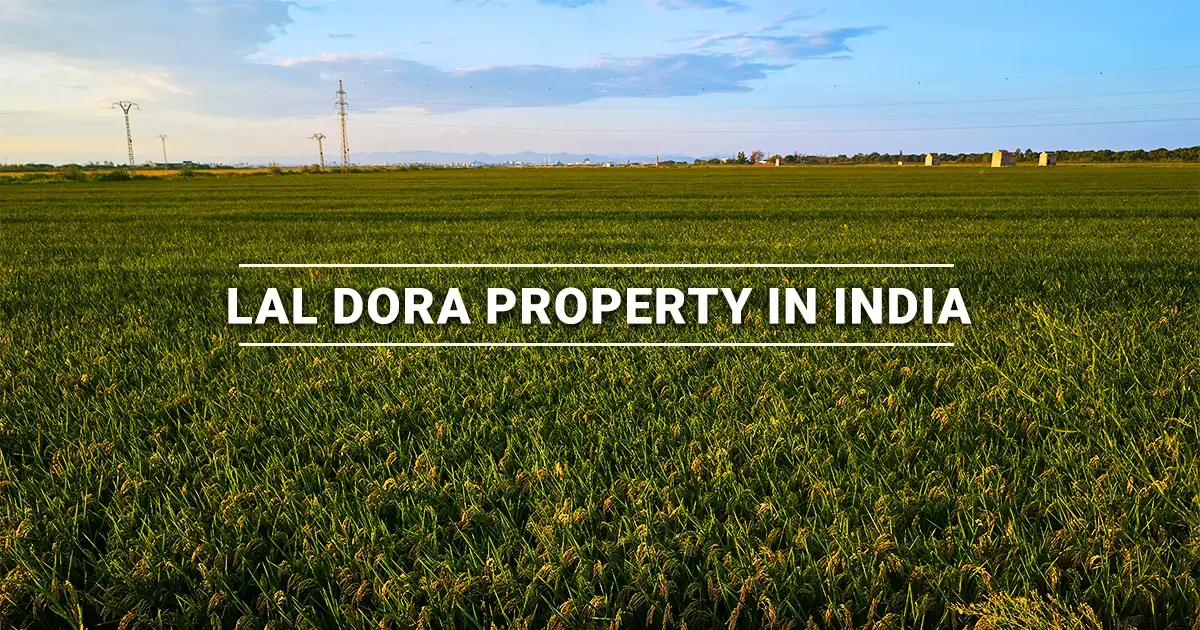Once upon a time, over a century ago, the Lal Dora land was an ingenious categorization devised to exempt village inhabitants from colonial taxes and urban authority. Today, however, Lal Dora property can be found where rural heritage meets powerfully aggressive urban development, often blurring the lines between what is legal and what is not, what is livable and what is sellable.
So, in today’s urbanized India, what is a Lal Dora land? How will the village laws of old adapt themselves to that marvellous skyline? Is such land registrable? Can it be transferred? What are the underhanded advantages coupled with the deadliest known perils?
These are not theoretical questions, especially in Haryana, where villages are now directly in the line of aggressive real estate activity; rather, they are financial, legal, and strategic imperatives. This blog is your complete guide to the realm of Lal Dora land, answering all critical questions every buyer, owner, or policymaker might want to know.
What is Lal Dora Land?
Initially intended to demarcate residential area (Abadi area) from agricultural lands adjoining villages, the Lal Dora land classification was introduced in 1908 under the British. A red line was drawn in the village revenue map to signify this separation, hence the term “Lal Dora” (Lal meaning red and Dora referring to boundary).
Lal Dora land, in legal and administrative parlance, refers to the land within the red demarcation, intended for residential and village community uses. The properties within this boundary tend to be exempt from municipal building codes, land use controls, and some tax exemptions, giving the villagers more freedom in constructing and making their homes on an ancestral property.
Lal Dora Land Means: Historical Purpose and Policy Background
The primary aim of the British administration behind this demarcation was the efficiency of rural governance. It gave autonomy to village people for their residential development without bureaucratic hindrances and allowed them to exercise localized management of the resources, construction, and occupancy.
This arrangement, however, sustained itself for a few decades. After independence, urban sprawl began swallowing many of these Lal Dora villages-especially in and around metropolitan areas like Delhi, Gurgaon, and Faridabad-and, therefore, questions about the legality, control, and future of such lands have begun to arise.
Can Lal Dora Property Be Sold?
Yes, selling a Lal Dora property is appropriate, but the process is bound by certain limitations and rules fixed by local governments. Like any de jure urban property, there are not even those among Lal Dora lands titled with formal property documents or valid zoning approvals; thus, transactions become quite windingly legally or financially dangerous.
Conditions for Sale: Proof of Ownership Verified: The seller must have proper documentary proof of ownership from either inheritance, mutation in revenue records or prior registered transfers.
Mutation Records: The land must have been mutated in the present owner’s name in the records of revenue.
Approval from Local Authority: Sale of Lal Dora Land in some jurisdictions needs clearance from the Tehsildar, Sub Divisional Magistrate (SDM) or Municipal Authority.
No Encroachment/Dispute: The property should not be in litigation or encroachment complaints.
While intra-family and village sales are the norm, any commercial sale to third parties often invites scrutiny by the local planning authorities, especially if such land is within the notified area for an urban expansion project.
Also Read: Mutation of Property Meaning, Process, and Importance for Buyers
Can Lal Dora Property Be Registered?

This is a yes, but the process is again very intricate. Registration of Lal Dora property is possible if the property is subject to state policies hereinafter, on village land, urban inclusion, and building regulations.
In the case of states like Delhi and Haryana, where earlier classification of some areas into Lal Dora has now given way to urban planning zones, registration can ensue when all of the following exist:
- Lal Dora Certificate.
- Mutation records updated in the name of either the buyer or the seller.
- Clearance from the local panchayat or urban development authority.
- No threats from ongoing land acquisition notifications.
In the absence of these, registration may be denied, or, on a few selected occasions, may be allowed under special schemes for regularization.
What is a Lal Dora Certificate?
A Lal Dora certificate is an official document issued by the Revenue Department or Sub-Divisional Magistrate (SDM) confirming that a property lies within the Lal Dora boundary of a village.
Key Functions of the Lal Dora Certificate:
Acts as legal proof of location within the village’s residential boundary.
Required to apply for registration, mutation, and in some cases, construction approvals.
Necessary for utility service applications (electricity, water, sewerage) in many jurisdictions.
Used as a reference document in litigation and inheritance cases.
Application Process for Lal Dora Certificate:
To obtain a certificate for Lal Dora, an applicant must submit:
Proof of ownership (e.g., inheritance deed, previous sale deed)
Property map or sketch
ID and address proof
Application to the SDM or local revenue office
Processing time can vary between 15 to 45 days, depending on district workloads and verification timelines.
What Are the Benefits of Lal Dora Property?
While there are legal and administrative ambiguities attached to Lal Dora land, there are also advantages that can accrue to those who are either ancestral landowners of Lal Dora land or stakeholders in a long-term investment.
Immunity from Building Bylaws
Traditionally, Lal Dora land had not been subjected to municipal construction approvals. Even if someone was starting to tighten up the thumb screws on modern regulations, generally accepted doctrines allow for foregone constructions under existing-use status.
The Cost Advantage
The value of Lal Dora properties is still very cheap as compared to anything within the urban or formally zoned property lines, so it becomes an attractive proposition for investors the less capital inow investors and locals.
Proximity to Urban Development
Due to unplanned urban sprawl, many Lal Dora villages are now bordered by commercial establishments, thus boosting the speculative value of such lands even further.
Inheritability
An easy passage of rights of inheritance has been granted to villagers over the Lal Dora land, as opposed to the succession rights plague associated with urban leasehold or DDA properties.
Lal Dora Property in Haryana: Status, Rules, and Future Prospects
In Haryana, particularly in regions like Gurgaon, Faridabad, Rohtak, and Sonipat, the Lal Dora property is rapidly assuming an urban character.
Key Features of Lal Dora Property in Haryana:
Inclusion in Master Plans: Many Lal Dora areas are finding their way into the urban master plans of HUDA, GMDA, and FDA.
Digitization of Land Records: Haryana is a frontrunner in DILRMP, where mapping and registration of Lal Dora land is being done through drones and satellite data.
DDJAY Schemes: Lal Dora lands in the urban periphery are being regularized for plotted residential development under the Deen Dayal Jan Awas Yojna, enhancing their resale and registration value.
Although there are these transformations, due diligence is paramount: prospective buyers should see legal advice, and the local Tehsildar offices, and check whether the property falls in no-construction or acquisition zones.
Also Read: Best Residential Areas in Gurgaon for Investment in 2025
Limitations and Risks of Investing in Lal Dora Land
Lal Dora land, notwithstanding its good sides, deals with risks that are always there:
Not Financially Aidable by Banks: Most big institutions do not give out loans for the purchase or construction of unregistered Lal Dora land.
Legal Disputes: Disputes for an unmeasured or disputed claim arising on the non-issue of title deeds and revenue entries may arise.
Mismanagement in Infrastructure: For almost all Lal Dora villages, the sewerage, drainage, and road networks are weak in their infrastructure, which are either privately developed or a public scheme-includable.
Limited Commercial Use: Hence, commercial activities for punishable offenders on Lal Dora land without re-zoning can lead to penalties or demolition.
Conclusion: Lal Dora Land—Historic Identity or Urban Investment?
Overall, Lal Dora classification has historical credence, but has now become an increasingly complex property classification. It attains many advantages with regard to site and cost, but one must approach it with utmost research. Whether you want to buy, sell, or develop Lal Dora properties in Haryana or anywhere, make sure:
- Know what constitutes a Lal Dora land from the legal and planning perspective.
- Obtain a proper Lal Dora certificate.
- Determine eligibility for sale and registration.
- Reach out to real estate lawyers and government planning offices.
As Indian states increasingly move toward digitized land records and integrated development, the future of Lal Dora lands will increasingly be in formalization, which is why now is the perfect time to act with clarity and caution.





Comments are closed